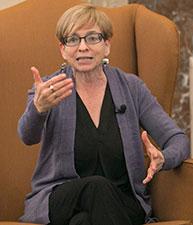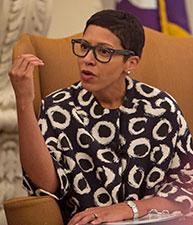As the #MeToo movement approaches its one-year anniversary, sexual misconduct allegations against powerful figures in media, business, politics and the arts continue to surface. On September 12, Chai Feldblum, a commissioner for the Equal Employment Opportunity Commission, spoke with Professor Melissa Murray about what individuals and organizations can do to prevent harassment and create safe environments for all.
The event kicked off this year’s speaker series for the Center for Diversity, Inclusion, and Belonging, and was co-sponsored by the Birnbaum Women’s Leadership Network and Law Women.
At the EEOC, Feldblum led a task force of academics, employers, and employees that in 2016 released a report focused on “rebooting” harassment prevention.
“Stopping harassment requires changing workplace culture,” said Feldblum. “Law is not necessarily the best mechanism for changing culture. It is, from my perspective, one essential element of changing culture, because it can help change culture, but it’s not the only one. If we’re depending on just law, we’re not going to get the success that we want.”
Most corporations have anti-discrimination policies, yet we have not seen greater diversity at the highest levels of organizations, noted Murray, referencing the book Working Law by Lauren Edelman at Berkeley Law. The legal interventions have provided a structure for compliance, but only symbolically, she said.
Feldblum observed a similar dynamic for workplace policies around harassment. According to the law, companies are not liable if they took preventative measures and responded appropriately to reports of harassment. The result: Companies offer training but do not ensure that the training was effective.
Changing workplace culture to prevent sexual harassment starts with leadership, according to Feldblum. C-suite executives have to articulate their values and expectations, and their actions must be seen as authentic by their employees. “The leaders have to actually believe in what they’re trying to do,” said the commissioner.
The EEOC report names about a dozen risk factors that indicate harassment might be present or even flourish at a workplace—for example, homogenous workplaces, workforces with many young workers, the presence of “high value” employees, workplaces that rely on customer satisfaction, or workplaces that tolerate or encourage alcohol consumption.
“When you read off that list,” said Murray, “you’ve basically described a law firm.”
Every workplace has some of these components, Feldblum said. In decentralized organizations such as retail chains, harassment can be a huge issue if the message from the executive office does not reach managers at the store level. For homogenous workforces, increasing diversity at higher levels helps change the workplace culture.
As for the problem of the superstar harasser—the high-value employee who harasses colleagues—the old calculation was that the cost of getting rid of the superstar was higher than the benefit. Research, however, shows that keeping a toxic worker results in adverse impacts on productivity, turnover, and reputation, according to Feldblum.
“Leaders of organizations are now beginning to see that they need to do a different cost benefit analysis,” said Feldblum. “We have to hold not only those who engage in harassment accountable...but managers and supervisors who choose to protect, for example, their superstar, instead of biting the bullet, sending it up the line, and getting rid of that person.”
Since the #MeToo movement began, the proportion of sex-based charges filed with the EEOC has gone up, according to Feldblum. Even though total harassment charges have dropped 12 percent in the first three quarters of fiscal year 2018 compared to the same period in the prior fiscal year, sex-based harassment charges have increased 3.4 percent, according to the commissioner. Likewise, the agency’s state offices have seen total charges drop by 3 percent, while sexual harassment charges have gone up 24 percent.
“Shame on us if we don’t use this opportunity to make the structural changes in workplaces that will stop harassment on all bases,” said Feldblum.
Posted October 5, 2018

